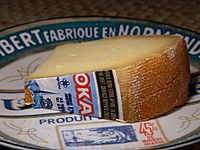Oka cheese facts for kids
Quick facts for kids Oka |
|
|---|---|
 |
|
| Country of origin | Canada |
| Region, town | The Laurentides, Oka |
| Source of milk | Cow |
| Pasteurised | Sometimes |
| Texture | semi-soft/creamy |
| Aging time | 1–2 months |
| Certification | - |
Oka is a special kind of cheese from Quebec, Canada. It's a semi-soft cheese with a unique "washed rind." This means its outside is washed during aging, which gives it a distinct flavor and smell.
Oka cheese was first made by Trappist monks in the town of Oka. The cheese is even named after this town! Today, a company still makes Oka cheese there, using the original recipe. The monks sold their recipe to a company called Agropur in 1981.
What is Oka Cheese Like?
Oka cheese has a strong smell and a creamy, soft taste. Some people say it tastes a bit nutty or fruity. It is made from cow's milk. The outside of the cheese has a copper-orange color because it's washed by hand.
Oka cheese tastes different from common cheeses like colby or cheddar. It doesn't go through the same "cheddaring" process. This makes its flavor truly special.
Types of Oka Cheese
There are a few different kinds of Oka cheese you might find:
- Regular Oka is made from pasteurized cow's milk. It ripens for about four weeks.
- Classic Oka is also pasteurized. It ripens for a longer time, usually two months.
- Providence Oka is very creamy and soft. It's even softer than the 'Classic' or 'Regular' types.
- Light Oka is similar to 'Regular' but has less fat. It is always pasteurized.
History of Oka Cheese
How Oka Cheese Began
Oka cheese has a rich history tied to the Cistercian monks. These monks lived at the Abbey of Notre-Dame du Lac in Quebec. They were very important in the cheese's creation.
In 1893, a monk named Brother Alphonse Juin came to the monastery. He brought a recipe for a cheese called Port-du-Salut from France. Brother Alphonse changed and improved this recipe. That's how Oka cheese was created!
The monastery also started an agricultural school. This school helped spread knowledge about farming and cheese-making. Over time, Quebec became a big producer of Canadian cheeses.

